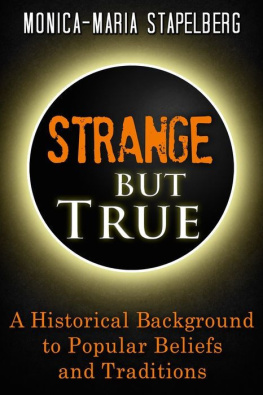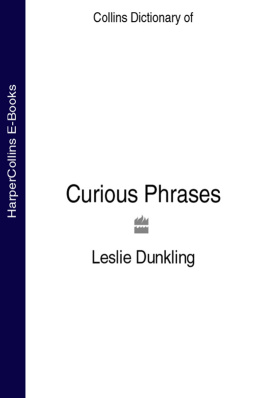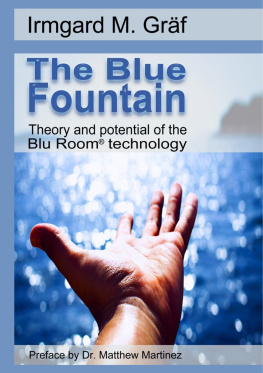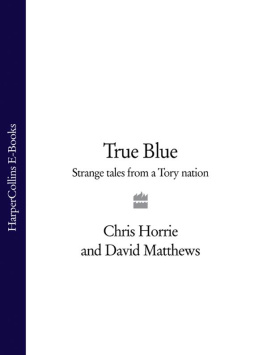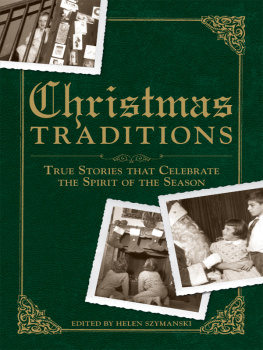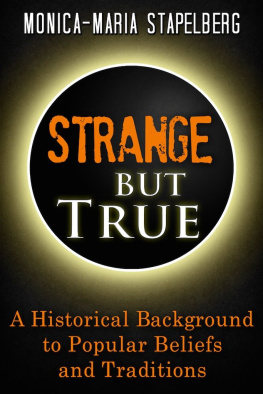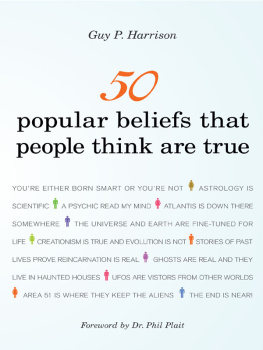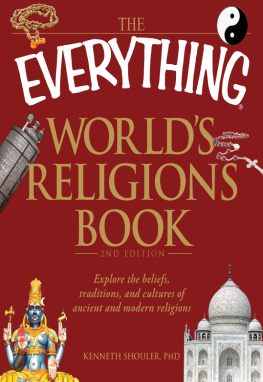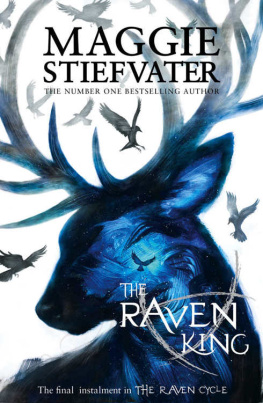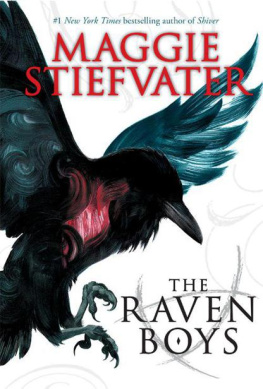Strange but True
by
Dr Monica-Maria Stapelberg

About the Author
Dr. Monica-Maria Stapelberg has been employed at various universities for many years as a lecturer in history of literature, as well as medieval languages, history, and cultural studies.
Since retiring from academia, she has had two books published, both aimed at the popular market:Old Wives Tales? A background to the origins of popular beliefs, traditions and superstitions (2004) and Curious and Curiouser! A historic background to some fascinating beliefs and traditions (2011). Both books have resulted in numerous radio interviews and talk shows.
Monica lives on the east coast of Australia with her family.
To Fred,
My wonderful husband, lover, and best friend
Introduction
Throughout history, humans have interpreted their surrounding world and its mysteries relative to their level of understanding. From ancient times to the Middle Ages and beyond, most of the population, from the humblest peasant to the most learned scholar, embraced a somewhat ignorant, sometimes preposterous and absurd viewpoint, when seen from a modern perspective. Because scientific explanations were unavailable, irrational fear and superstition of unexplained phenomena prevailed. Blind terror and sublime awe struck in the heart of the populace at the experiences of thunder, lightning, earthquakes, floods, droughts, mysterious sicknesses, and plagues. All such occurrences were attributed to the displeasure of higher powers, or the workings of demons, evil spirits, and witches.
The general populace often lived in dire circumstances and depended on the success of their crops and natures continuing influence on their daily lives. Fuelled by illiteracy and ignorance, strange notions and beliefs thrived amongst humanity, where the poorer classes made up most of the population, and the distinction between rich and poor was enormous. An implicit belief in the power of witches, devils, fairies, dangerous mythological beasts, and various demons officially sanctioned and categorised by the Church, instilled horror and fear.
All these factors compounded to form the unquestioning assumption of supernatural forces external to humans, regarded as tyrannical, capricious, and highly dangerous, and hence, to be appeased or driven away at all costs. This led to the development of an intricate system of elaborate safeguards against unknown powers, thereby laying the foundation for many beliefs and traditions still observed.
Often, we are unaware that certain actions, gestures, and codes of etiquette, which we observe and perform on a day-to-day basis, are actually based on relics of long forgotten ancient beliefs, anchored in archaic ritual magic, past sacrificial observances, or simply fearful superstition. When someone sneezes, we immediately respond with a bless you, or we cover our mouths when yawning and coughing. We consider it ill mannered to point at someone and take pains not to leave our knives and forks crossed on our plates when having finished a meal. We believe these actions to be good manners and do not realise they are originally born of superstitious dread. Why do we dress baby boys in true blue, trick or treat on Halloween, kiss under the mistletoe, wear the wedding ring on our ring finger, or show someone the finger in contempt?
There is only a difference in degree between worshipping a tree as our distant ancestors did and touching wood, in the vague belief that to do so will ward off some calamity. We still christen a ship by breaking a champagne bottle against its bow, refer to ships and sailing vessels as she, throw coins in a fountain while making a wish, ceremoniously lay a buildings foundation stone, and wet a newly built houses roof reminiscent of a time when all these were considered magic acts to appease higher forces.
Relics from the past are buried like forgotten treasures in our figures of speech. We use these frequently, unaware of how ancient, profound, and loaded with symbolic and precise meaning many are. For example, we say everyone has a skeleton in the cupboard, not realising this once had a literal meaning. We say if looks could kill, which relates to the belief in the evil eye, still widely prevalent in many European countries, the Middle East, Asia, and Africa. Similarly, we refer to a lily-livered coward, an expression harking back to ancient divination practices; or we speak of walking in someones shadow, once a universal taboo; or being spellbound, dating from a time when spells or words were thought to have the power to bind and root someone to the spot.
The material for this book was collected and researched over many years and pertains predominantly to Western culture. However, wherever beliefs and traditions have been found to be in common with those of cultures in other parts of the world, references to their similarities have been made. The myriads of facts presented highlight the historic origins of many beliefs and traditions, as well as their fascinating and often strange but true origins.
Monica-Maria Stapelberg
Chapter 1
MAGIC PRACTICES
A belief in various forms of magic was once common in most communities and still exists in many societies. For example, in Aug 2014 newspapers in the United Kingdom widely reported the discovery of a young Nigerian boys dismembered body floating in the River Thames near Tower Bridge in London. Experts testified that the wounds on the boy were consistent with those of ritual killings practiced in western and southern parts of Africa where human sacrifices are still often used to tap supernatural powers for magic purposes. Every year hundreds of Africans lose their lives in ritual murders by tribal members who go in search of human body parts at the behest of witchdoctors or traditional medicine men. These human body parts are used in magic rituals or potions, to ensure the witchdoctors clients have success in finance, business, politics or other ventures. Similar news reports are still found in many developing countries, where traditions in magic continue.
Magic, as a protective and procuring agent, has existed universally in all cultures since ancient times. It can be described as a ritual activity that aims to produce an affect on the physical world by using supernatural powers. Ritual magic also attempts to control powerful supernatural forces such as a spirit, a god, a demon, or a cosmic force through elaborate ceremonies. Magics ultimate goal is supreme authority over all things, but a distinction must be made between black and white magic. Whereas black magic aims to destroy and harm, white magic aims to affect the community and individuals beneficially.
In traditional tribal societies, the magician or sorcerer is seen as all-powerful and is never questioned. For example, during the Zulu uprising in South Africa in 1906, the witchdoctor applied war medicine, believed to immunize the Zulu warriors against bullets, to all battle-ready men. Believing in the witchdoctors power and his medicine or magic, hundreds of Zulus, armed only with assegais, hurled themselves at the British batteries of rifles and guns. They were mowed down almost to a man. Yet, no one would have thought to question the medicine mans efficacy the loss of life simply meant the enemys medicine was stronger. Generally magic has always been seen as immune to failure if it does not work, the procedure followed is deemed incorrect or the counter-magic applied is seen as superior.
Magic practices range from rituals involving the entire community, such as those for successful hunting or a plentiful harvest, to peripheral or minor magic acts concerned with individual community members. Simple magic, often called sorcery, involves practices such as tying or untying knots; rituals involving human or animal blood, hair, and nails to cast spells; and sticking pins or sharpened splinters in waxen images, small dolls, or poppets. There are two main types of magic: contagious magic and sympathetic magic.
Next page
